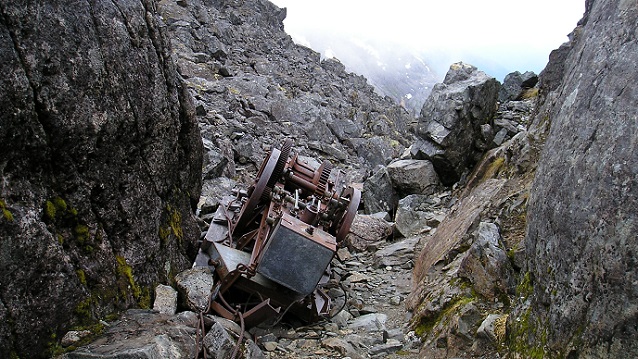Near the summit of Chilkoot Pass, often in fog, rain, or snow, hikers encounter a pile of rusted metal and wood; a reminder of the gold rush that used this corridor, and the heavy burdens stampeders carried with them.

NPS photo
What is it?
This artifact is a gas engine winch, abandoned after the Klondike gold rush.
Where is it?
The gas engine winch is located on the Chilkoot Trail near the false summit of Chilkoot Pass. This artifact is easy to find and often spotted and photographed by Chilkoot Trail hikers. Depending on snowfall you might only be able to see the engine winch in August and September.
Description
The gas engine winch is 11 feet long, 2.5 feet wide, and 2.5 feet high. The engine retains many of its original components: ferrous metal and brass parts, rubber fuel hoses, metal gas tank, metal winding drum, crank shafts, and fly-wheels. The engine is designed to pump the crank fitted to the frame and geared to the winding drum. Cable guides are attached to the front of the frame. Two wood skids are attached to the base of the engine frame.
More about the engine winch
The gas engine winch is one of the few remaining artifacts associated with pioneer Archie Burns. Being a component of Burn’s surface tram operation used to haul stampeders' goods, the engine adds to our knowledge of structures and artifacts related to the gold rush, as well as methods of transportation. As an individual industrial artifact, it adds to the knowledge of construction techniques and materials available at the turn-of-the-century.
This “winding engine” was originally designed for hoisting at mining prospects. Being a portable artifact during the gold rush, the location of its use is not yet known. It presumably came to rest in this location after snow melt, and the original location would have been on snow pack at a higher elevation. The engine would have had to of been horizontally level in order to function properly, and tied down to keep it from moving during operation.

NPS photo/C. Carley
In 1979, when Klondike Gold Rush National Historical Park was a brand new park, an archeologist from the park service was sent to inventory historical and cultural artifacts in the new park. In one summer Caroline Carley inventoried Dyea, the Chilkoot Trail, and the White Pass units of the park. One of the artifacts she documented was the gas engine winch found near the trail at Chilkoot Pass.
Over the years, archeologists have continued to monitor this artifact for looting, damage, and degradation.

NPS photos
Last updated: August 14, 2017
